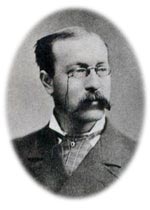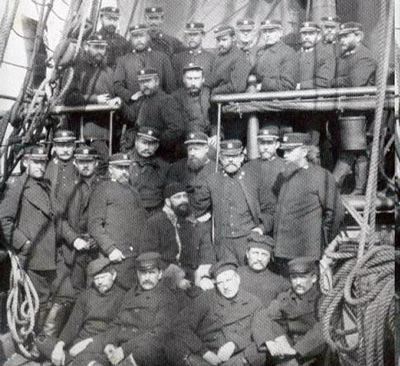|
History
 |
 |
LT George W. DeLong
Source: Newcome, Raymond Lee, Our Lost Explorers,
The Narrative of the Jeannette Arctic Expedition,
Hartford Conn., American Publishing Company, 1884. |
|
The Jeannette Expedition (1879-1881)
An attempt to verify Petermann's "Open
Polar Sea" theory was launched by US naval officer George
Washington De Long, who was able to convince newspaper proprietor
James Gordon Bennett to sponsor a cruise to reach the North
Pole via the Bering Strait. Departing in 1879, the small steamboat
Jeannette was trapped in the ice for two winters, and eventually
crushed and sank. Some of the crew survived a harrowing ordeal
that included hauling tons of supplies and three boats over
hundreds of miles of ice, a blizzard swept voyage, and an arduous
trek across the Siberian tundra.
References:
Guttridge, L.F., Icebound: The Jeannette Expedition's Quest
for the North Pole, Airlife Publishing Ltd., Shrewsbury,
England, 357 pp., 1988.
Holland, C., ed., Farthest North: The Quest for the North
Pole, Carroll & Graf Publishers, New York, 311 pp., 1994.
 |
 |
| | W. S. Schley and his relief expedition crew with the six survivors of the Greely Expedition, June 1884
Source: Reynold, Francis J. The United States Navy
From The Revolution To Date, New York: P. F. Collier
& Son, 1918, p63. |
The Greely Expedition (1882-1884)
The first International Polar Year was established for 1882-1883,
where eleven nations pledged to establish 15 new observation
stations in the Arctic and Antarctic. The most remote locale
was a US station at Lady Franklin Bay, under Army officer Adolphus
Washington Greely. Besides scientific observations, it was a
less publicized goal to reach the North Pole, or at least beat
the English Farthest North. Twenty-five men wintered over twice
at the station which they called Fort Conger. Marred by close
circumstances, clashing personalities, long periods of darkness,
failed supply efforts and starvation, only 6 survived.
References:
On the web: Greely Expedition Directory
Holland, C., ed., Farthest North: The Quest for the North
Pole, Carroll & Graf Publishers, New York, 311 pp., 1994.
 Previous Chapter
Next Chapter Previous Chapter
Next Chapter

|



